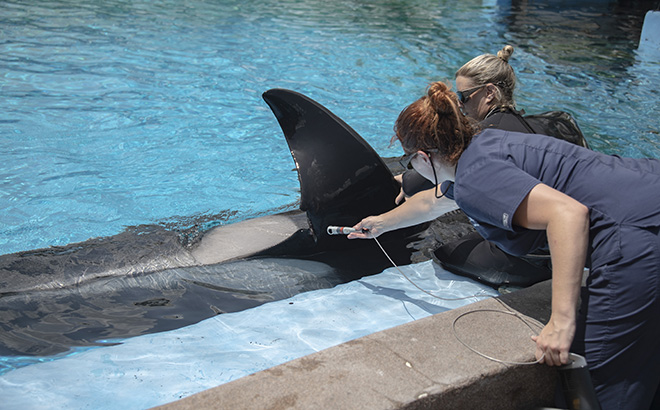Caring for Katina
6/13/2018 Update: We’re glad to share that Katina continues to heal as expected from a recent dorsal fin injury. Our veterinarians have used a regimen of cold laser therapy and honey to stimulate her body’s ability to heal. She’s made significant progress, as her skin has grown over the injury. Her fin will have an altered appearance – much like a scar – but no long-term medical concerns.
As we shared earlier, our veterinary team has monitored Katina daily and she’s continued to behave normally throughout her recovery, engaging with the pod and showing no signs of discomfort. Guests can visit her at any of our One Ocean encounters.
On Saturday, March 17 the matriarch of the SeaWorld Orlando orca pod, Katina, sustained an injury at the base of her dorsal fin as the result of interactions with other members of the orca pod. The SeaWorld veterinary and animal care teams responded immediately to conduct a full exam on Katina, where they determined the injury was isolated to the base of her dorsal fin. Her behavior is already back to normal, and over the next several weeks the veterinary and animal care teams will continue to monitor and treat her wounds, including topical honey treatments and cold-laser therapy.

How is the team treating Katina’s injury?
Our veterinary and animal care teams are monitoring and treating Katina’s wound, including utilizing cold-laser therapy and medical honey treatments to promote healing and help prevent infection.
Why are you using lasers and honey to treat her?
Medical honey has actually been used for thousands of years to treat wounds. Medical honey is toxin-free and sterile and promotes wound healing and helps kill bacteria. Similarly, cold-laser therapy also promotes healing and helps prevent a secondary infection. Dolphins and whales are excellent wound healers, so the primary purposes of her treatments is to prevent a secondary opportunistic infection.
Has she been separated from other members of the pod?
Katina is currently in a separate pool with her daughter, Nalani, and son, Makaio, so she can rest and allow her dorsal fin to begin healing.
Why is Katina not in the med pool where the team can keep a closer eye on her?
Katina’s behavior has already returned to normal. She is responding to her trainers, so the veterinary and animal care teams determined there was no need to unnecessarily separate Katina and they are confident they can treat her as she continues to interact with other members of her pod.
Do you know which whale injured her?
While Katina was near Trua, a 12-year-old male, at the time, she was interacting with several members of the orca pod, so it’s not clear exactly how she sustained that injury.
Will Katina’s dorsal fin fully heal?
Dolphins and whales are excellent wound healers and, just like with any injury, the time it takes to heal may vary. While our veterinary and animal care team will continue to monitor and treat Katina’s wounds over the next several weeks and months, we do expect Katina’s dorsal fin will have permanent changes, as a result of the injury.
Is this the result of them fighting?
Killer whales are a social and hierarchal species, so interacting with other members of the pod, even in an aggressive or antagonistic manner, is a natural behavior we’d expect to see. However, it’s not clear if this was the result of an aggressive behavior or other interactions within the orca pod. If you’d like to learn more about natural orca behavior visit http://www.nmfs.noaa.gov/pr/pdfs/recovery/whale_killer.pdf.
Has this happened with these orcas before? Others at SeaWorld?
Killer whales are a social and hierarchal species, so interacting with other members of the pod, even in an aggressive or antagonistic manner, is a natural behavior we’d expect to see.
Does this happen because they are in captivity and have aggression issues?
No, this is a common occurrence among wild killer whale pods, as well as those at SeaWorld. Killer whales are a social and hierarchal species, so interacting with other members of the pod, even in an aggressive or antagonistic manner, is a natural behavior we’d expect to see.


